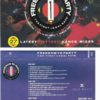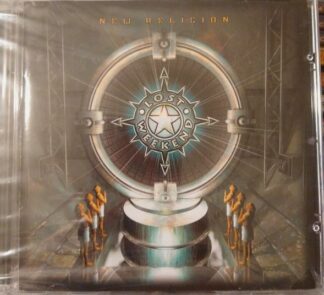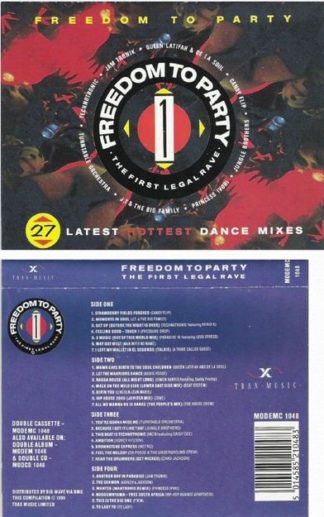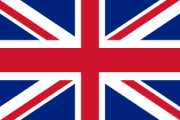Description
THIS IS THE ONE AND ONLY COPY WE CAN SELL TO YOU, ONCE THIS SELLS WE WILL NOT BE ABLE TO SELL THIS TAPE AGAIN.
Freedom To Party 1 – The First Legal Rave
Label: Trax Music MODEMC 1048
Format: 2 × Cassette, Compilation
Country: UK
Released: 1990
Genre: Electronic, Acid House, Techno, House
Tracklist:
A1 Candy Flip Strawberry Fields Forever [The Beatles cover]
A2 J.T. And The Big Family Moments In Soul
A3 Technotronic Get Up (Before The Night Is Over)
A4 Pressure Drop Feeling Good – Touch 1
A5 Paradise 10* 2 Music (Out Of This World Mix)
Featuring Less Stress
A6 Man With No Name Way Out West
A7 A Tribe Called Quest I Left My Wallet In El Segundo (Talkie)
B1 De La Soul Mama Gave Birth To The Soul Children
Featuring Queen Latifah
B2 Addis Posse Let The Warriors Dance
B3 Simon Harris Ragga House (All Night Long)
Featuring Daddy Freddy
B4 Beatsystem Walk On The Wild Side (Lower East Side Mix)
B5 Lincoln Jean Marie Givin You
B6 Zone (10) Hip House 2000 (Jupiter Mix)
B7 House Crew, The All We Wanna Do Is Dance (The Peoples Mix)
C1 Turntable Orchestra You’re Gonna Miss Me
C2 Jungle Brothers Because I Got It Like That
C3 MC B This Beat Is Technotronic
Featuring Daisy Dee
C4 Honey Hylton Ambition
C5 Metro Brownstone Express
C6 Da Posse And Underground Crew, The Feel The Melody
C7 Chad Jackson Hear The Drummer (Get Wicked)
D1 Jam Tronik Another Day In Paradise
D2 Ashley & Jackson The Sermon
D3 Princess Ivori Wanted (Mantronix Remix)
Remix Mantronix
D4 Hip-Hop Against Apartheid Ndodemnyama – Free South Africa
D5 F’N’M This Is The Big One
D6 Yo Lady Yo Lady Yo

There was quite a bit of reported psychedelic and club drug use at these all night events, which gave rise to negative media attention. Acid house was banned from radio, television and media outlets

Genre Creation in the United Kingdom (1990s)
By the early 1990s, it became more challenging for promoters to organize one-off events. New bylaws were passed in an attempt to discourage promoters from holding raves. Despite this, organizations such as Fantazia, Universe, N.A.S.A. (Nice and Safe Attitude), Raindance, Amnesia House, ESP, and Helter Skelter were holding large-scale legal raves in warehouses and fields.
Around the same time, new musical styles including jungle and happy hardcore began to emerge. The scene began to divide as it became difficult to set up parties with multiple rooms for different genres.
In May 1992, the government in the UK passed a bill that focused on electronic dance music and raves. It gave police the right to stop open air parties, two or more promoters who were organizing raves, and people on their way to raves. After 1993, most raves took place in licensed venues, including Helter Skelter, Life at Bowlers, the Edge, The Sanctuary, and Club Kinetic.
Around the same time, drum and bass was born from a fusion of hardcore, house and techno. It originated in the breakbeat hardcore sector of the UK’s acid house scene. Both DnB and jungle featured breakbeats played over fast 4/4 dance beats. Records like The Prodigy’s ‘Jericho’, Rebel MC ‘The Wickest Sound’ and A Guy Called Gerald ‘Anything’ (below) helped to shape the sound that would become drum and bass
A selection of the hardcore tracks being produced had a light and upbeat style. In response to this, a group of producers began to focus more on darker sounds and darkcore, a style that influenced jungle was invented. Here’s an example of darkcore in Goldie’s classic ‘Terminator’
The darker sound appealed to the reggae and dancehall community, and soon dub remixing techniques were incorporated into the sound, alongside samples from urban music. It was common for producers to cut apart loops to create increasingly complex breakbeats; the most popular break to sample from was the Amen Break.
Producers who quickly became popular included GrooveRider, LTJ Bukem, and Andy C. 1994 was the peak of jungle; this was the year jungle was most influenced by rasta vocals and ragga basslines. Rave promoters began taking note that jungle was gaining popularity, and created parties with names like “Jungle Mania” and “Fantazia takes You Into the Jungle”.

By 1995, a counter style to ragga jungle emerged, dubbed ‘intelligent’ drum and bass. The king of this scene was LTJ Bukem and his label, Good Looking. This new sound focused more on warm tones and atmospherics and was a contrast to the aggressive ragga style. Fabio, Doc Scott, Grooverider, Photek and Dillinja were all active producers and DJs who pushed the new sound forward.
Roni Size, Krust and Dj Die might be considered the DJs who made Drum and Bass more mainstream – as well as Goldie. In 1995, Goldie released his masterpiece “Timeless” (below) which sold over 150,000 in UK alone.
The genre started entering the club scene, with DnB DJs beginning to get booked for house-oriented clubs. Ministry of Sound started to hold drum and bass sessions. Even as the sound continued to gain popularity in the mainstream, the writing was on the wall for the rave scene. An organization called World Dance put on their “last” rave at Lydd Airport. “Here is your last chance before another chapter in ‘Rave History’ comes to an end!” the adverts posted around London proclaimed.
1990s in the United States

One of the forefathers of the rave scene in the US is DJ Scotto. Inspired by the fabled club Hacienda in the UK, in 1992 he put on Manhattan’s first rave at the Studio 54 venue (then called the Ritz). The party featured (among others) DJ Frankie Bones, Rozalla and Moby performing live.
Frankie Bones would go on to start his own successful series of raves in Brooklyn, Storm Raves – where future international DJs like Josh Wink and Sven Väth got a chance to perform. Frankie also allegedly was the man behind the concept of PLUR, having once famously yelled on the microphone during a fight at a Storm Rave:
“If you don’t start showing some peace, love, and unity, I’ll break your faces.”
Many smaller promotional groups sprung up in the US, which caused a real ‘scene’ to develop, and Scotto’s NASA collective (Nocturnal Audio and Sensory Awakening) went on to produce rave tours that featured Moby, Prodigy, Orbital, Aphex Twin and then-emerging producer Richie Hawtin.
In the 1990s, one of the most prominent rave promotion crews was Global Underworld Network. They organized the OPIUM and NARNIA Festivals that drew an incredible attendance of over 60,000 people. Narnia was featured on MTV and twice in Life Magazine, and honored as the Event of the Year in 1995. Narnia became known as the “Woodstock of Generation X”.
During the late 1980s and early 1990s, the Bay Area experienced a surge in popularity in rave culture. Small, underground parties began to take off, and expand from SF into the surrounding areas. With no curfew in place, venues would have up to 20,000 people partying every weekend. By 1991, raves were exploding, and flyers could be found up and down Haight Street. ‘Homebase’, and ’85 & Baldwin’ were two of the biggest venues that raves were held at in the Bay Area – but raves also appeared in open air venues (watch three different SF area raves in the video below).
In LA, promoters Vince Bannon and Phil Blaine brought in acts like 808 State, Aphex Twin, Massive Attack and Prodigy to play. California became a notorious destination for raves in the United States. The world flocked to attend parties that took place there and listen to the internationally renowned DJs who played.





![LOST PROPHETS: Thefakesoundofprogress CD [Gold album in the UK, Nu Metal success]](https://yperano.com/wp-content/uploads/2016/03/18024-LOST-PROPHETS-Thefakesoundofprogress-CD-Gold-album-in-the-UK-Nu-Metal-success.jpg)



Reviews
There are no reviews yet.